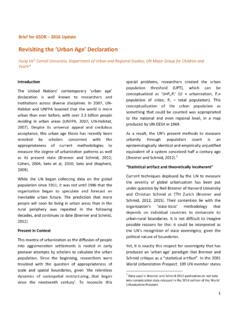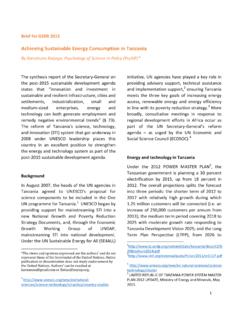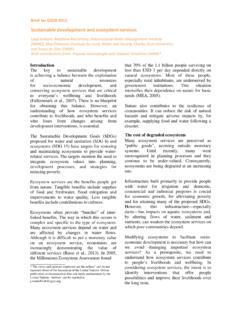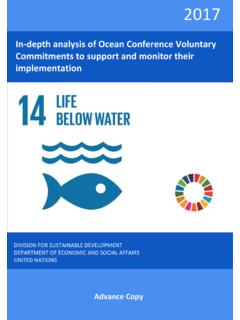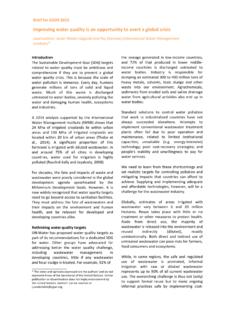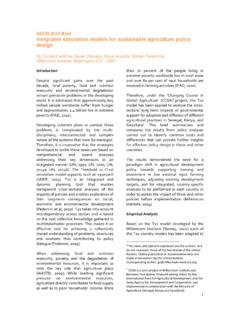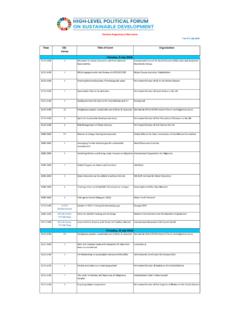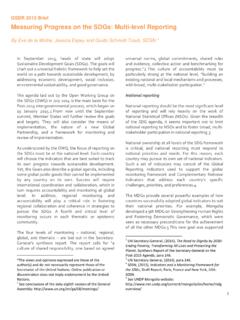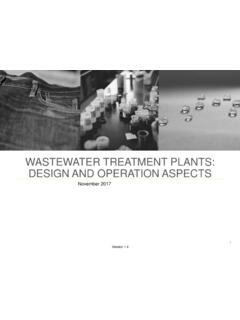Transcription of Economic and Social Dimensions of Sustainable Development
1 IAEA International Atomic Energy Agency Economic and Social Dimensions of Sustainable Development Prof. Roberto Schaeffer 4-6 February 2015 Panama City, Panama Workshop on Capacity for Mainstreaming Energy Sustainable Development Goals (SDGs), Targets and Indicators into Statistical Programmes in Selected Latin American Countries IAEA Special thanks to .. The International Atomic Energy Agency (IAEA) and Giovani Vitoria Machado (from EPE, Brazil), from whom we borrowed many slides IAEA Definition of Sustainable energy Development .. Development that lasts and that is supported by an economically profitable, socially responsive and environmentally responsible energy sector with a global, long-term vision (IEA, 2001) IAEA In 1999, IAEA initiated the Project Indicators for Sustainable Energy Development ISED, in cooperation with various international organizations, to.
2 Fill the need for a consistent set of energy indicators Assist countries in energy and statistical capacity building required to promote energy sustainability Supplement work of the Commission on Sustainable Development -CSD (general indicators for Sustainable Development ) Original name has changed to Energy Indicators for Sustainable Development EISD to avoid misunderstandings Some considered that Sustainable energy Development refers only to renewable energy This has not changed the basic concepts, the methodology and the indicators themselves ISED/EISD Phases First Phase (2000-2001): identification of a set of potential indicators and Development of the conceptual framework (definition and classification) Second Phase (2002-2005): original set and framework refined and practical utility demonstrated (implementation) Cases: Brazil, Cuba, Lithuania, Mexico, Russian Federation, Slovak Republic and Thailand Some background IAEA Indicators are statistical tools for systematic analysis, decision making, policy formulation and tracking policy effectiveness Evolutionary tool: Indicators are about trends and changes over time Indicators and their statistical requirements have to be in harmony with national capabilities and priorities Users do not have to implement the full set, but can select those indicators that are relevant Users do not have to be constrained by ISED/EISD proposed, but can create other indicators that are appropriate for their case Generating Indicators is only a beginning to.
3 Clarify statistical information Monitor progress of past energy-related policies Provide a reality check on policy proposals Combinate with energy system modelling Concept and Methodology IAEA Indicators, statistics, models and analyses/policies Analyses / Policies Statistics Models Indicators Can be incorporated on models or help checking and validating results Are derived from statistics Are bases for analyses and policies formulation and monitoring IAEA Economic State Environmental State Social State State of energy sector Driving forces from Energy sector of Economic dimension Impact from energy sector Impact from energy sector Responses of institutional Dimension Institutional State Sustainability Dimensions of the Energy Sector IAEA Conceptual framework Originally, based on the relations of driving forces, states and responses (DSR) following conceptual framework established by CSD 41 ISED/EISD indicators The indicators categories encompassed the following aspects: Indirect Driving Forces: underlying factors influencing a variety of causes, both direct and indirect; Direct Driving Forces: directly cause (or may cause) Social , Economic and environmental impacts; State indicators: show current conditions of a specific dimension: Social , Economic , environmental and institutional; Response actions: agents/society actions and policy measures to solve the problems reflected in state variables.
4 IAEA 19. Income inequality 20. Ratio of daily disposable income per capita of 20% poorest population to the prices of electricity and major households fuels 21. Fraction of private consumption spent on fuel and electricity by: average population; 20% poorest population 22. Fraction of households: heavily dependent on noncommercial energy; not using electricity 23. Amounts of air pollutant emissions (SO2, NOx, particulates , CO, VOC) 24. Ambient concentration of pollutants in urban areas (SO2, NOx, suspended particulates , CO) 25. Land area where acidification exceeds critical load 26. Amounts of green house gas emissions 27. Atmospheric radioactive discharges 28. Discharges of oil into coastal waters 29. Generation of solid waste 30. Accumulated quantity of solid wastes to be managed 31. Generation of radioactive waste from nuclear power fuel cycle chain 32.
5 Accumulated quantity of radio-active wastes awaiting disposal 33. Area of land taken up by energy facilities and infrastructure 34. Dislocation of population by hydro reservoirs and open-cast coal mines 35. Fatalities due to accidents(energy sector with breakdown by fuel) 36. Proven fossil fuel recoverable reserve 37. Life time of proven fossil fuels reserves 38. Proven uranium reserves 39. Life time of proven uranium reserves 40. Intensity of use forest resources as fuelwood 41. Rate of deforestation : total;urban per capita energy prices with and without tax/subsidy of sectors in GDP value added traveled per capita by transport mode transport activity area per capita structure (Manufacturing value added by selected energy intensive industries) intensity (Manufacturing, Transportation, Agriculture, Commercial&Services, Households) energy intensity of selected energy intensive products mix (end-use energy, electricity generation, primary energy supply) supply efficiency of deployment of pollution abatement technologies use per unit of GDP on energy (total investments, RD&D, environmental control, energy import expenses) production consumption per capita of net energy imports(+)/exports(-)
6 To consumption Full list of Original ISED/EISD IAEA Main Topics Covered Global climate change Air pollution Water pollution Wastes Energy resource depletion Land use Accident risks Deforestation Energy accessibility Energy affordability Energy disparities Economic activity levels Energy production, supply and consumption Energy pricing, taxation and subsidies End-use energy intensities (selected Economic sectors, manufacturing industries) Energy supply efficiency Energy security Environmental Dimension Social Dimension Economic Dimension IAEA Indirect Driving Forces Direct Driving Forces State Responses Energy intensities of Economic sectors and selected products Final energy consump-tion mix Final energy demand Electricity generation mix by fuel types Societal actions and policy measures to solve Economic problems Response Actions Energy sector Economic sector Energy supply efficiency Primary energy supply mix Status of deployment of pollution abatement technology Population; total, urban; GDP per capita; End-use energy prices with and without tax/subsidy Manufacturing structure Economic activity levels; Floor area per capita Transport activity levels and mode mix Energy services demand Energy use per unit of GDP.
7 Expenditure on energy sector: Energy consumption per capita; Indigenous energy production; Net energy import dependence Framework Identifying ISED/EISD Flow of Economic Dimension IAEA Our Focus Here: Economic Dimension of Sustainable Development Energy balances introduction (already covered) So, our focus here will be on: Energy efficiency of supply systems Overall energy intensity (basic energy indicators) Efficiency of Economic sectors (using energy indicators combined with value added or industrial production data) Fuel diversification and renewable energy Energy security IAEA Energy Efficiency of Supply Systems What is energy efficiency? First-law efficiency? Second-law efficiency? What is a supply system? What is a demand system? Is distributed generation (DG) part of the supply or of the demand system? IAEA Energy Efficiency of Supply Systems IAEA 15 Efficiency of thermal power plants (public utilities only) in Brazil Year % Year % 1980 1990 1981 1991 1982 1992 1983 1993 1984 1994 1985 1995 1986 1996 1987 1997 1988 1998 1989 1999 IAEA Transmissions and Distribution Losses (IEA, 2014) IAEA Overall energy intensity (basic energy indicators) Economic energy intensity (or energy intensity - IE) Energy (primary or final?)
8 Per GDP (MER or PPP?) Energy (primary or final?) per VA Energy (primary or final?) per capita Physical energy intensity (or specific energy intensity SEC) Energy (primary or final?) per physical unit (ton of product, pkm, tkm) How to deal with international trade? IAEA Annual electricity consumption per capita (2007) kWh World Average USA India 704 28% China 1,484 60% World 2,465 - USA 13,456 545% - IAEA Overall energy intensity (basic energy indicators) (IEA, 2012) IAEA Overall energy intensity (basic energy indicators) (IEA, 2012) IAEA Energy per capita and primary energy intensity in Brazil per capita(toe/inhabitant)TPES/GDP(toe/ 2009 USD thousand)IAEA 22 Energy and electricity use per unit of GDP in Brazil Energy Intensity (TPES)Electricity 1980, TPES/GDP was MJ/US$-2000 ppp, and Electricity/GDP was kWh/US$-ppp 2000.
9 IAEA Efficiency of Economic sectors Using energy indicators combined with value added or industrial production data Economic energy intensities (IE) Physical energy intensities (SEC) IAEA Household electricity consumption per capita per year 010002000300040005000 NorthAmericaOECDAsia &PacificEuropeMiddle-EastCISL atinAmericaChinaOtherAsia AfricaIndiaWORLDkWh/cap1980199020002006 IAEA Electricity intensity in the Service Sector IAEA Final energy consumption and VA in the Brazilian Industry (Machado e Schaeffer, 2006) 05001,0001,5002,0002,5003,00019701971197 2197319741975197619771978197919801981198 2198319841985198619871988198919901991199 219931994199519961997199819992000 PJMining and quarryingNon-metallic mineralsIron and steelNon-ferrous metalsChemicalsFood and beverageTextilesPulp and paperOther industries050100150200250300350400197019 7119721973197419751976197719781979198019 8119821983198419851986198719881989199019 91199219931994199519961997199819992000 Billion US$ppp,at constant 2000 pricesMining and quarryingNon-metallic mineralsIron and steelNon-ferrous metalsChemicalsFood and beveragesTextilesPulp and paperOther industriesIAEA Final energy intensity trends in Brazil (Machado e Schaeffer, 2006)
10 1357911131519701971197219731974197519761 9771978197919801981198219831984198519861 9871988198919901991199219931994199519961 997199819992000MJ/US$ppp,at constant 2000 pricesAgricultureIndustryServicesEnergyE conomy*IAEA Total Primary Energy Supply (%) Overview in long-term changes: strong fall in fuelwood vs. robust increase in oil Sugar-cane products and hydro also increase Fuel diversification and RE in Brazil Source: MME-EPE (2010) IAEA Large share of renewable sources: 47% in 2009, 41% as of 2014 Fuel diversification and RE in Brazil Total Primary Energy Supply Brazil 2009 Brazil vs. World & OECD Source: MME-EPE (2010) Source: MME-EPE (2010), IEA (2009) IAEA Large share of electricity generation comes from renewables 70-90% in Brazil (includes imports from Itaipu Binational) 18% in the World (average according to IEA, 2009) Fuel diversification and RE in Brazil Source: MME-EPE (2010) IAEA Large share of biofuels in transport: 21% in 2009 (15% today) Anhydrous ethanol + Hydrated ethanol + biodiesel Fuel diversification and RE in Brazil Source: MME-EPE (2010) Jet fuel Fuel Oil Electricity Flex-fuel vehicles 1 Mtoe ~ 42 PJ IAEA Energy security Net energy import dependency?
